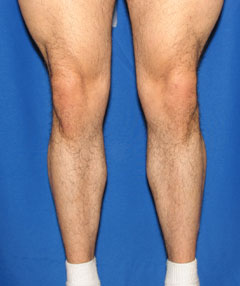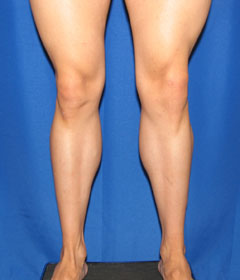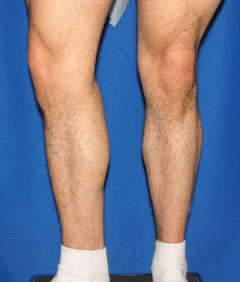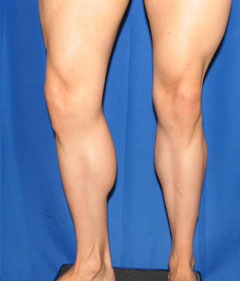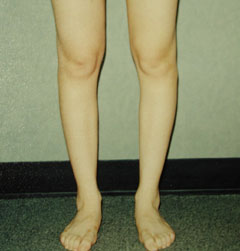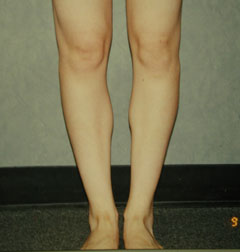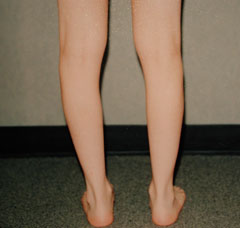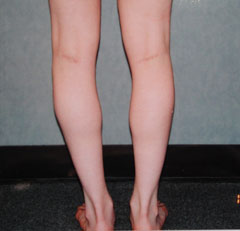What Are Calf Implants And What Do They Do?
Calf implants (calf augmentation) enhance the shape and size of the calf muscles by placing soft, solid silicone implants in pockets overlying the existing gastrocnemius muscles. The calf muscle is a two-headed muscle (one head on the upper inside of the leg and the other on the upper outside of the leg) on the back of the leg that attaches on each side of the femoral bone just above the knee and extends down the leg ending as the Achilles tendon at the heel.
These implants which may be one to each leg or two depending on the desired effect are placed through small incisions in the creases behind the knee. A person may desire to have only the inner head of the muscle enlarged, the outer head, or both. The result is that the existing musculature is made to appear larger and more defined.
Who Would Be A Candidate For Calf Implants?
Many people are dissatisfied with the shape/size of their calf muscles to the point that they avoid wearing garments that expose their legs. In these instances, even intensive exercise may not significantly enlarge the calf muscles, particularly in relation to one’s larger thigh muscles. Calf implants can also be used to correct deformities resulting from injury or nerve diseases that result in muscle deterioration. Such deformities include, polio, club foot, spina bifida. Calf implants using solid, soft silicone implants addresses these problematic areas.
Men and women seek calf implants for different reasons. While men typically seek an appearance that emphasizes the bulk of the calf muscle, women usually desire calf implants for purposes of anatomical balance, where the lower leg is sculpted to be more proportionate to the thighs. Bodybuilders traditionally seek to improve the dynamics of this hard-to-develop muscle group. The difficulty for body builders arises from the location of the muscle ‘belly’ in relation to the bone insertion. Simply stated, depending on the proximity of the belly of the muscle in relation to the knee and ankle, one can spend a lifetime working on muscle development and show little results. Usually, those individuals with a high muscle belly, often called a high insertion, have great difficulty in building calf mass, because of the lack of striated muscle in the area. Those with a low insertion can usually achieve more mass, but lack the definition that often accompanies the high insertion muscle type. Fortunately, calf implants can solve both scenarios by adding both mass and definition. Read more about Bodybuilders and Calf Implants.
A critical element in determining the right size and shape is based on the skill of the surgeon who can assess the proportions correctly, and properly sculpt and place the implant, thereby anticipating any changes after the surgery.
Generally, anyone in average physical condition or good health can be a candidate for calf implant surgery. Read more about Calf Implant Surgery.
How Are They Used?
Implants can vary in size from 10″ in length and 6″ in width—but generally vary, depending the surgeon’s skill and experience in doing the final sculpting of the silicone piece—and are beveled usually with no more than a maximum 1″ in thickness. They are inserted through a small 3 cm incision below the hip bone near the Greater Trochanter. They lie just under the fascia of nearby muscle, which conceals them entirely from the outside. Cosmetic hip implants are often inserted along with other aesthetic procedures such as liposuction or breast implants.
What Can I Expect During Recovery?
The legs are measured at a pre-operative office visit and the appropriately sized implants are ordered and prepared sterile. On the day of surgery the patient is placed under general anesthesia and turned onto the stomach on the operating room table. An incision is made in the fascia of the gastrocnemius muscle. The fascia is a fibrous covering of the muscle itself. A special instrument is used to create a pocket between this fascia and the underlying muscle. This pocket is made just big enough for the implant to fit into securely. During the dissection meticulous attention is made to control any bleeding which is usually very minimal. The implant is then gently inserted into the pocket and the same technique is used to insert the second implant into the same leg. The leg is examined for effect and if the result appears good then the incision in the fascia is closed with stitches. The person is returned to a face-up position and is taken to Recovery.
The Recovery period can be divided into short-term surgical recovery and long term cosmetic recovery. The surgical recovery is the first week or so following the procedure itself. During this time the person is instructed to walk around but when lying or sitting to have the legs elevated which reduces swelling and, therefore, reduces discomfort. The first day or two the patient is in bed with legs elevated most of the time but is up to the bathroom with assistance and may even walk around short distances. After two days the dressings are removed and the person is encouraged to begin a more vigorous routine of walking around. This allows the muscles to start becoming accustomed to having the implants present and allows the skin of the legs to start stretching and feeling more comfortable. After the dressings are removed the person may take short daily showers. After the first week or so the person usually is beginning to feel more comfortable walking greater distances even if it is walking a little stiff-legged. A person usually is walking more normally after a couple to three weeks but is very variable. This generally begins the long-term recovery phase.
It is during the long-term recovery phase, which begins a couple to three weeks after surgery that more normal walking begins and the skin begins to stretch and loses its shiny appearance. There may be some slight bruising around the incisions and this begins to disappear. A special scar prevention/lessening medication is begun about two to three weeks following surgery. No vigorous activities such as weight lifting, bicycling, running, etc. One can usually progress to those activities about a month or two following the surgery but is dependent on any persistent discomfort or swelling and varies from person to person. Without complications, a person is usually back to full, unrestricted activities a month or two following surgery.
The patient is usually able to return to full physical activities within 4-6 weeks.
What Are Potential Risks & Complications?
As with any surgery, there are some risks, albeit minimum. Some include infection, bleeding, nerve and/or muscle damage, slippage and asymmetry.
Calf Implants for Congenital and Physical Defects:
Polio (Polio Eradication Initiative), Spina Bifida (Spina Bifida Association of America) and Clubfoot (Talipes Equinovarus; Talipes/American Academy of Orthopedic Surgeons), are defects caused by genetic deformities and/or diseases that can affect the lower bone and musculature of the body. While calf implants are not a cure for these ailments, they can provide anatomical balance, when needed, in less serious cases. Depending on the extent of the defect, calf implants can help. Our surgeons are among the leading surgeons in helping people with these ailments achieve anatomical balance through the use of implants.
Poliomyelitis — is a disease caused by viral infection. Highly contagious, it invades the nervous system and can cause total paralysis. It largely affects children under five years old, often leaving partial or complete paralysis in the lower legs, and there is no cure. It can, however be prevented by vaccine, which will last for a lifetime. In 2002, there were only 1900 cases reported. Calf implants can help give patients with the condition more balance to the calf muscle area.
Spina Bifida — is a neural tube (crest) defect (NTD) that affects the complete development of the nervous system including the brain, spinal cord and protective tissue structures. It is a genetic birth defect and affects one tenth of one percent of all births occurring in the U.S. Because of the nature of the disease, quite often it affects mobility and can result in the use of crutches and braces. Calf implants can help patients where one calf muscle is thinner or smaller than the other—due to nerve damage—and can help with a more balanced leg appearance.
Clubfoot — a birth defect, clubfoot affects the foot and ankle areas, where the heel and toes can be turned inward. Instances of clubfoot have been medically documented for decades, and approximately 66% of all instances occur in boys. Serial casting, a method whereby the bones of the affected areas are slowly stretched to their normal positions, puts the bones of the foot in normal alignment. Sometimes the condition can affect the development of the calf muscles, often leaving one muscle smaller than the other. Calf implants can aid in creating the natural anatomical balance one desires.
Important Questions to Ask Before Choosing your Surgeon:
So you’ve finally decided to get calf implants. You’ve probably been thinking about it for some time. The only thing to do now… is to find the right surgeon who can assure you’ll receive the best success without any problems.
To begin, it’s EXTREMELY IMPORTANT to realize that very few surgeons perform calf implants. The fact is… it’s a very, very unique procedure and few perform it on A REGULAR BASIS.
Some surgeons will say they perform calf implants. But, the key is to find someone fully qualified, that performs the procedure AT LEAST ONCE A MONTH. That means, the surgeon you choose, should average approximately one every week.
Why is this SO IMPORTANT?
Because calf augmentation is a unique operation that requires aesthetic skill… more so, than most people realize. Here’s why—
1) Due to the stress placed on gastrocnemius muscle and achilles tendon (commonly called the calf muscle and tendon that connects it to the heel bone) during common, everyday activities such as walking, standing and running, implants placed in this area will be subjected to intensive movement. Thus, the likelihood of an implant shifting or moving after surgery is a concern.
Needless to say, having one’s right leg look dramatically different than the left, due to an implant shift, won’t generally result in the aesthetic ‘look’ one usually desires.
The bottom line, is that it’s critical to have the expertise—gained from performing numerous calf implant procedures—to successfully pick the proper area of the gastrocnemius muscle within the fascia, the implant pocket, so that the calf implant is assured of not shifting out of place… and over time, it eventually becomes an integral part of the muscle. This knowledge is ONLY GAINED by performing this procedure frequently. Our surgeons are well known as some of the very best at this procedure.
2) Another extremely important consideration—one that every patient needs to be aware of — is the primary reason WHY they’re having the surgery even performed… the final results. How they’ll look AFTER the operation is completed.
Again, you should realize that calf implants are solid, silicone prosthetic devices. So, they must usually be carved, or shaped, before insertion. So, having the expertise to properly shape the implant, a process where the surgeon artfully sculpts the solid silicone device with a scalpel before insertion, so it appears natural yet enhancing, for each individual body type is also critical.
There’s nothing more eye-catching after surgery, than a poorly sculpted calf implant… one that somehow seems oddly fit for the individual’s body type.
Our surgeon’s artistic abilities are evident in most everything they do. Their aesthetic style in sculpting the calf implants for each individual’s leg size and type has been gained from years of expertise, only developed by having done so many procedures. They are specialists at performing calf implants on people with birth/genetic and physical defects such as Polio, Spina Bifida, and Clubfoot, helping them achieve completely natural appearances, in many cases, for their affliction.
Here are a few critical questions you should ask you prospective surgeon before you decide on having Calf Implants:
How many calf implants did the surgeon you’re considering do last month? How many last week? How many in the last three months? Just remember, calf implant procedures require that the surgeon isn’t merely a ‘visitor’ to this type of surgery…but, someone who is a ‘regular’.
Ask the surgeon if you can speak with his most recent few calf implant patients. Any surgeons who perform this procedure regularly won’t have a problem letting you speak with their former patients.
Ask him if he’s ever had any complications from implant shifting, or infection. A poor decision, based on cost, or lack of experience can come back to haunt you.
Before & After Photo Gallery


